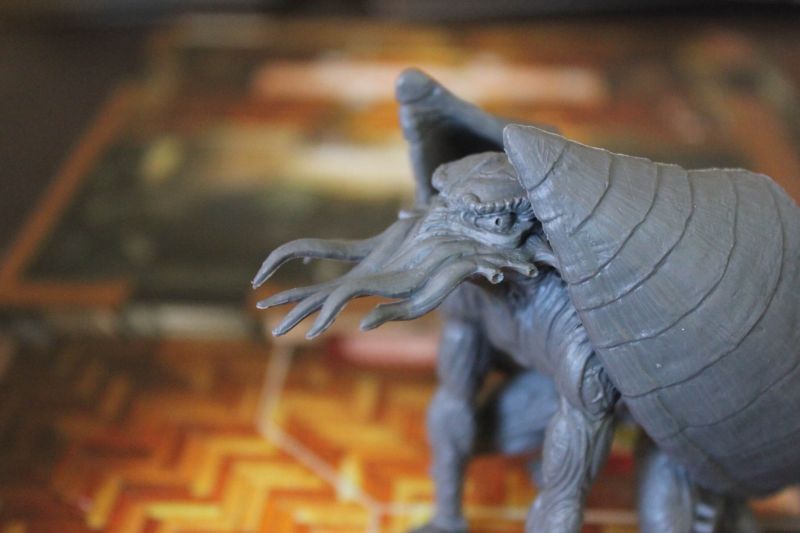
I don’t do things in half measures.
When I got into modern board games back in 2010, I jumped in with both feet. One of the first games I bought was the giant Lovecraftian classic Arkham Horror. The 2005 game is just one game in a long string of Cthulhu-themed horror noir titles from publisher Fantasy Flight, but it perhaps best defines the company’s ethos when it comes to converting the Old Ones to cardboard: go big or go home.
Arkham was a huge, bloated mess of a game (hey, for some people, that’s a compliment), but its 2013 follow-up Eldritch Horror streamlined Arkham’s systems and made the game a much more playable—but still 3+ hour and rules-heavy—experience. Arkham tasked a team of investigators with fighting back the forces of world-consuming darkness in a small 1920s city; Eldritch took the action to the world stage, whisking teams of players off on globetrotting missions to close portals to horrific realms.2011’s Mansions of Madness kept the same setup—world-eating Elder Gods, a hapless team of investigators, a box so heavy you could beat Azathoth himself to death with it—and zoomed down to the most intimate setting yet, sending a team of characters bumbling into a spooky mansion to investigate a mystery. It was kind of like Scooby-Doo, but instead of unmasking the villain to find a middle-aged man with too much time on his hands, uncovering the truth meant staring down a many-tentacled cosmic horror intent on destroying humanity.

Here was the game’s first problem. Anyone who has played the “bad guy” in a one-vs-many game knows the temptation to play the role as more of a kindly DM. Sure, it can be fun to crush the hopes and dreams of a roomful of friends, but Mansions of Madness was a storytelling game. Winning as the keeper often meant cutting short everyone’s enjoyment of figuring out the mystery. Balance concerns only compounded the problem.
Then there was the arguably larger problem that setting up the original game was an absolute buzz-killing chore, and the entire responsibility fell on the shoulders of the keeper. Worst of all, one small error in the setup could render the mission unsolvable for the investigators. The first edition was a beloved but flawed game, and many horror game fans were left wondering, “What if there were a game just like this… but better?”
With the wildly hyped new second edition of Mansions of Madness, Fantasy Flight has attempted to fix all these issues with one simple tweak—replacing the human keeper with an app.
-
The giant box of Mansion of Madness Second Edition.
-
Each investigator has his or her own miniature and stat card.
-
-
Lovely evening for a fight to the death with a bunch of cultists.
-
You'll find items that will help you during your investigations. As in real life, you can chug some whiskey to recover lost sanity.
-
Of course, there are plenty of nasty status effects you can be afflicted with.
-
Big pile of monsters and their ill-fitting bases.
-
It wouldn't be a Cthulhu game without dice. Elder signs are successes, blanks are misses, and clue symbols can be converted into successes if you spend clue tokens.
-
When you take damage or lose sanity, you draw cards. Some are "just" regular wounds and horror; others are more insidious.
-
The mansion tiles come in only two sizes, so finding the tile you need is a snap.
-
Tokens!
-
Owners of the first edition of the game were not forgotten; the new game comes with a kit that lets you convert your monsters and investigators into the new ruleset.
An app?! In my board game?!
For some people, the fact that the new Mansions of Madness requires the use of an app (available for free on iOS, Android, and Steam) is enough to immediately discredit the entire thing as an example of the misguided pursuit of novelty in board game design. We play tabletop games to get away from electronics! What happens when the app is no longer supported? What if there’s a game-breaking bug?
All valid concerns, but as I was poking around in the app for the first time, I had an even bigger question. Why is this even a board game?
The app generates the maps, randomizes the encounters, and narrates the adventure. Is this just a tablet game whose redundant physical components were produced solely to justify a $100 price tag? What does the app actually bring to the table? EXPLAIN YOURSELF, APP.
I brought my furrowed-brow reservations to my first session... and was shocked to see how quickly the game won me over. As it turns out, the app is fantastic. (I shouldn't have been too surprised; this isn't FFG's first dalliance with app-driven board games.) It took me about two turns to stop thinking of the app as an app and to see it instead as just another game component—one that actually sucks up all of the previous game’s fiddliness and says, “You just play the game, I’ve got this.”
Gone is the original game's onerous setup time. Just dump out some piles of tokens, separate a few stacks of cards, pick your investigator, hit “start” on the app, and you’re good to go. The app reveals the board to you as you investigate, and it tells you where to put tokens and when to spawn monsters. It doesn’t keep track of where you or the monsters are on the board, but it does track monster health and let you know when and how monsters move and attack.
Since the game is still an RPG-like experience, I found it's best to have one person control the app and read the narration to the other players.

When you place a new room tile, the app will narrate its features with some flavor text.
You step into the hallway. The lights flicker dimly overhead as your footsteps echo down the passage.
It will then tell you where to put exploration tokens—points of interest in each room that you can interact with.
A small pile of papers sits on a disheveled desk.
Finally, exits are marked with even more flavor text.
You hear a strange scratching sound coming from the north door.
And then players are free to take turns moving around and exploring. If someone wants to check out that disheveled desk, for instance, the app controller would tap on the in-app token and read out the text of the encounter. You might find an item—in this case, an arcane manuscript or a magnifying glass—represented by (real life) cards that give small buffs to help in your investigation. The magnifying glass, of course, lets you roll an extra die on observation checks.
reader comments
34